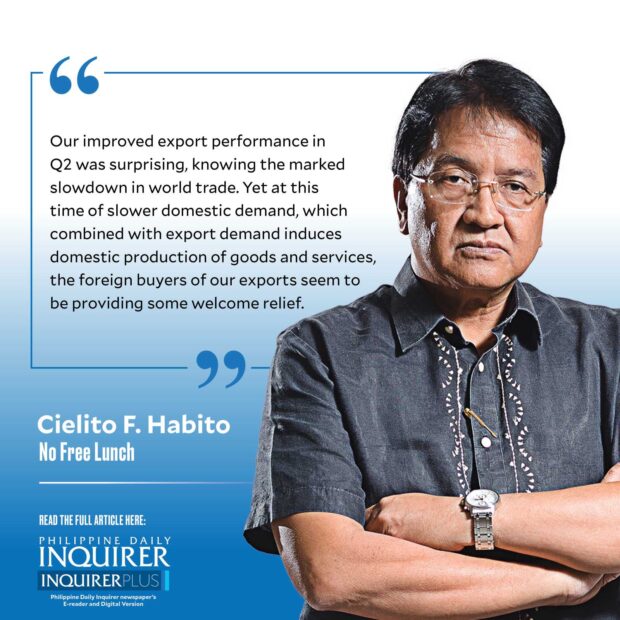Ramping up exports
 Amidst the disappointing slowdown of the Philippine economy in the second quarter (Q2), only one item on the demand or spending side actually improved over Q1: our exports. Quarter-on-quarter merchandise export growth, adjusted for seasonality, was 8.6 percent, translating to 39 percent annualized growth. In contrast, all components of domestic spending—household and government consumption, and investment spending—all shrank from their first quarter levels at -1.0, -5.4, and -4.4 percent, respectively (or -4.1, -22.5, and -18.8 percent in annualized rates).
Amidst the disappointing slowdown of the Philippine economy in the second quarter (Q2), only one item on the demand or spending side actually improved over Q1: our exports. Quarter-on-quarter merchandise export growth, adjusted for seasonality, was 8.6 percent, translating to 39 percent annualized growth. In contrast, all components of domestic spending—household and government consumption, and investment spending—all shrank from their first quarter levels at -1.0, -5.4, and -4.4 percent, respectively (or -4.1, -22.5, and -18.8 percent in annualized rates).
Our improved export performance in Q2 was surprising, knowing the marked slowdown in world trade. Yet at this time of slower domestic demand, which combined with export demand induces domestic production of goods and services, the foreign buyers of our exports seem to be providing some welcome relief. Interestingly, it’s exports of goods rather than services that gave the Q2 boost, while the latter (where business process outsourcing or BPO is prominent) actually shrank by 5.3 percent from Q1. This suggests to me that being a tiny player in the huge global export market, we could still aim to ramp up our export growth to recover and sustain our economic momentum in the years ahead, even amidst a world trade slowdown. But we need to be deliberate in finding growth opportunities, especially for nontraditional exports in nontraditional markets, with strategic spadework from our trade representatives overseas.
I’ve written before about how woefully behind our neighbors we are in export performance. In 2022, our $79 billion in merchandise exports was a mere fraction of Thailand’s $287.4 billion, Indonesia’s $292 billion, Malaysia’s $352.5 billion, Vietnam’s $371.7 billion, and Singapore’s $515 billion. Not even our human exports yielding some $32.5 billion in annual remittances, and our BPOs yielding us another $32.5 billion in revenues, brings us close to what our neighbors already earn from goods exports alone. But this also suggests that there is wide scope for us to grow our export earnings. For this, we need to overcome two age-old barriers to our faster export growth that prevent us from catching up with our Asean peers. These are lack of scale, and lack of integration and coordination in our export industries.
Overcoming the first barrier entails large-scale production of raw materials at volumes that ensure sustained supplies for various manufactured export products. But our highly fragmented lands due to agrarian reform, made worse by continued generational partitioning among heirs, make this a formidable challenge. With average farm size now at just about a hectare, we need effective clustering and consolidation schemes that will permit commercial-scale agricultural production. But while ideal, it’s also extremely difficult to operationalize, with Filipino producers said to be kanya-kanya (individualistic or selfish) in their attitude. This has kept cooperatives from achieving the wide success seen in other countries around us like Thailand, South Korea, and Taiwan. The quicker and more realistic solution would be to lift land ownership ceilings and permit large-scale land ownership by agribusiness investors, as recommended in the Philippine Export Development Plan 2023-2028. In nonagriculture-based manufacturing, we must aggressively pursue “big-ticket” global export firms (like Samsung in Vietnam or Ford in Thailand), which by their sheer size could singlehandedly boost the country’s trade numbers. The new CREATE law permits the President to customize incentives in order to woo such large investors into the country.
Lack of integration is especially seen in gaps in the value chains of major export products, such as copper and its downstream products. The domestic copper industry mainly exports it in its basic processed form of cathodes, while domestic manufacturers and exporters of wires, cables, and wiring harnesses must import copper rods, plates, and billets. The gaps in our copper value chain highlight the need to foster and catalyze investments that would fill those gaps and thereby complete and integrate the domestic product value chains.
Integration and coordination failure is likewise seen in the persistent jobs-skills mismatch plaguing export manufacturing and service industries; unwillingness of small producers to team up to be able to service volume orders (kanya-kanya again); inefficiencies and higher business costs due to weak coordination across government agencies; and lack of technology, innovation and commercialization/upscaling support for existing (e.g., bananas) and emerging (e.g., new generation electronics, electric vehicles and batteries) export winners.
Yes, we can ramp up our exports. We know what we need to do. We need to just do it.
—————-




















